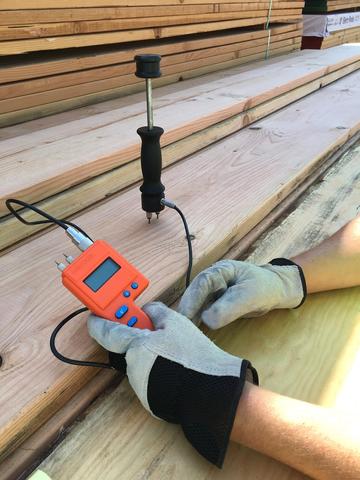
NIST’s proposed test procedures for softwood lumber include a section on using moisture meters to measure the moisture content of wood, which significantly affects its final dimensions.
For some, it is a shocking revelation. But most Americans eventually come to accept the fact that a “two by four” board is actually 1.5 inches by 3.5 inches (38 x 89 mm). But is it really? How accurate are the dimensions of boards found at hardware stores and lumber yards? It’s the job of state and local inspectors to answer that question by making measurements periodically at retail locations, or earlier in the supply chain.
But at present there are no nationally agreed-upon test procedures for inspectors to follow in checking the accuracy of softwood* lumber dimensions. To rectify that problem, NIST’s Office of Weights and Measures (OWM) has drafted a set of proposed test procedures designed to ensure that those measurements are made uniformly, accurately, and reliably.
The term “two by four” is considered a “nominal size,” used to describe approximate rather than actual dimension. Nominal sizes were originally derived from dimensions of rough lumber before being surfaced (made smooth, even, and uniform in size and shape) at the mill.
Determining whether lumber is produced to proper sizes by the mill is complicated by numerous factors. For example, the dimensions of softwood lumber are impacted by moisture content changes, density, species, and grain orientation. Measurements made at easy-to-reach ends of boards can be misleading. Different inspectors may use different kinds of measuring devices -- and may select samples to measure using different criteria.
These and other problems make it hard to evaluate errors, difficult to compare findings, and impossible to cite a recognized measurement standard when, for example, lodging a complaint about wrongly sized lumber.
That’s why OWM, in cooperation with the industry-based American Lumber Standards Committee (ALSC) and the California Division of Measurement Standards, has developed a detailed set of proposed testing procedures, and will submit it soon for consideration by the National Conference on Weights and Measures (NCWM),** which sets the consensus standards for all states to use.
“Over the last couple of years, several states have requested guidance on how to test softwood lumber,” says OWM’s David Sefcik. “But what has been lacking is something that gives the inspectors step-by-step guidance in how to test it, what equipment to use, how to account for varying moisture content, and more.”
There are specifications for method of sale — that is, labeling, dimensions, and definitions of terms and lumber types — in NIST’s Handbook 130, “Uniform Laws and Regulations,” under Section 2.10, Softwood Lumber. Further guidance is found in Voluntary Product Standard PS 20-15, “American Softwood Lumber Standard.” But until last August, no one at NIST had focused on test procedures.
“We developed a training class for inspectors on products sold by count, linear measure, area, and thickness,” Sefcik says. “Of course, OWM offers extensive teaching and training in a wide variety of areas. But it was the first time we’ve ever taught this particular class. In the course of doing so, it became clear that there was a need to provide inspectors with some procedural guidance for softwood lumber. So that’s when we started developing these test procedures. We just took the opportunity to move forward.”
A first draft of the test procedure was introduced during that August of 2016 training class to participants from the NIST “Train the Trainer” program, who assisted OWM by providing valuable feedback. The eight participants represented Arizona, California, Connecticut, Michigan, West Virginia, and Wisconsin. With their input and suggestions, the proposed procedures were revised and improved.
The current draft version gives specific practical specifications for nearly all aspects of softwood inspection, including the kinds of calipers (for thickness and width) and steel tape (for length), the minimum quality and method of deployment for wood moisture meters, dimensional correction factors for moisture content (e.g., 1% shrinkage for each 4% change in moisture content) in different species, and many other factors.
In a few months, OWM will submit the proposed procedures to a regional group (i.e., Southern Weights and Measures Association) of NCWM to begin the vetting process. If adopted after review, the proposal will then circulate to other regional groups, gathering further suggestions and comments. If all goes well, by summer of 2018 the proposal will move to the docket of NCWM, which can vote to approve it.
After NCWM adoption, the test procedures will be included in NIST’s Handbook 133, “Checking the Net Contents of Packaged Goods,” which is the “Bible” of recognized consensus practices for verifying the net quantity of contents of packages kept, offered, or exposed for sale, or sold by weight, measure (including volume and dimensions), or count at any location.
“Providing standard test procedures will benefit more than just the state inspectors in doing their job,” says Douglas Olson, Chief of NIST’s Office of Weights and Measures. “As consumers we will be able to depend on the quality of the products we purchase at the lumber yard, and producers and retailers will have confidence that the marketplace is fair. Really, this will be a very good thing for everyone involved.”
* The softwood category includes pine, spruce, fir, cedar, and redwood, among others.
** The National Conference on Weights and Measures is a professional nonprofit association of state and local weights and measures officials, federal agencies, manufacturers, retailers, and consumers. NCWM has developed national weights and measures standards since 1905.
NOTE: Any mention or depiction of commercial products within NIST web pages is for information only; it does not imply recommendation or endorsement by NIST.

